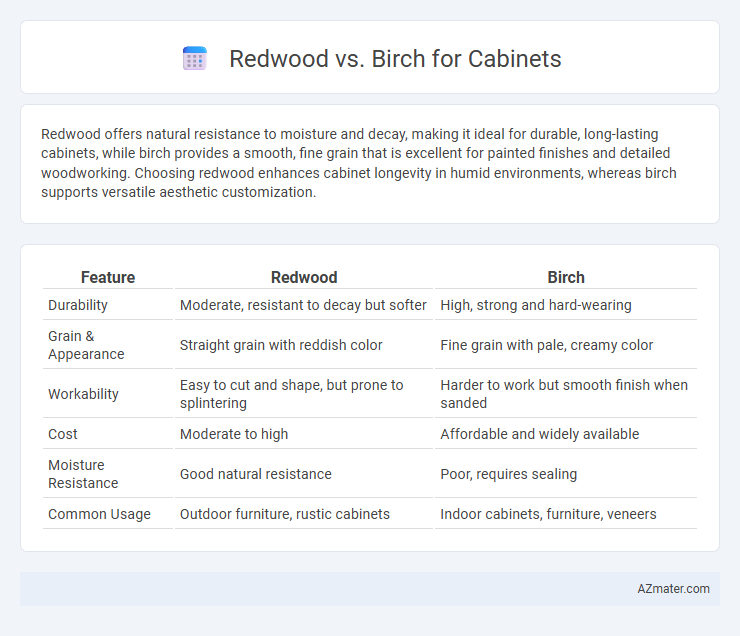Redwood offers natural resistance to moisture and decay, making it ideal for durable, long-lasting cabinets, while birch provides a smooth, fine grain that is excellent for painted finishes and detailed woodworking. Choosing redwood enhances cabinet longevity in humid environments, whereas birch supports versatile aesthetic customization.
Table of Comparison
| Feature | Redwood | Birch |
|---|---|---|
| Durability | Moderate, resistant to decay but softer | High, strong and hard-wearing |
| Grain & Appearance | Straight grain with reddish color | Fine grain with pale, creamy color |
| Workability | Easy to cut and shape, but prone to splintering | Harder to work but smooth finish when sanded |
| Cost | Moderate to high | Affordable and widely available |
| Moisture Resistance | Good natural resistance | Poor, requires sealing |
| Common Usage | Outdoor furniture, rustic cabinets | Indoor cabinets, furniture, veneers |
Introduction to Redwood and Birch Cabinets
Redwood cabinets offer exceptional durability and natural resistance to decay and insects, making them ideal for moisture-prone environments. Birch cabinets provide a smooth, fine grain and a light color that takes stain well, allowing for versatile design options in both traditional and modern kitchens. Both woods are valued for their strength, but redwood's rustic appeal contrasts with birch's clean, uniform appearance, influencing aesthetic choices in cabinetry.
Appearance and Grain Patterns
Redwood cabinets showcase a rich reddish-brown hue with a straight, uniform grain that conveys warmth and elegance ideal for rustic or contemporary interiors. Birch offers a lighter, creamy color palette complemented by a fine, smooth grain pattern that provides a clean, modern aesthetic suitable for bright, minimalist spaces. The pronounced grain of redwood enhances natural character, while birch's subtle grain allows for versatile staining and finishing options.
Durability and Hardness Comparison
Redwood cabinets offer moderate durability with natural resistance to decay, making them suitable for moisture-prone environments, though they have a Janka hardness rating of around 450, indicating softer wood. Birch, with a higher Janka rating of approximately 1260, provides superior hardness and resistance to dents and scratches, ensuring longevity in high-traffic kitchen areas. Choosing between Redwood and Birch for cabinets depends largely on the desired balance between natural resilience and hardness, with Birch favored for durability and Redwood preferred for its aesthetic and moisture resistance.
Cost and Affordability
Redwood cabinets typically cost more than birch due to their natural durability and rich color, making them a premium choice for high-end cabinetry. Birch offers a more affordable option with a smooth, uniform grain that takes stains and paints well, making it versatile for budget-conscious kitchen remodels. Choosing birch can significantly reduce overall cabinet expenses while still providing a durable and attractive finish.
Sustainability and Environmental Impact
Redwood cabinets offer sustainability advantages due to their rapid growth rate and natural resistance to decay, reducing the need for chemical treatments. Birch, while durable and widely available, often requires more intensive processing and finishes, increasing its environmental footprint. Choosing sustainably harvested redwood with FSC certification supports forest conservation and lowers carbon emissions compared to birch sourced from less managed forests.
Workability and Ease of Installation
Redwood offers superior workability due to its straight grain and softer texture, allowing for easier cutting, shaping, and sanding in cabinet making. Birch, while harder and denser, provides more resistance during installation but results in a durable, smooth finish that holds nails and screws firmly. Choosing between Redwood and Birch depends on prioritizing ease of manipulation with Redwood or enhanced stability and long-term durability with Birch during cabinet installation.
Maintenance and Cleaning Requirements
Redwood cabinets require minimal maintenance due to their natural resistance to moisture and decay, making them ideal for kitchens with fluctuating humidity levels. Birch cabinets, while durable, need regular sealing or finishing to protect against water damage and stains, ensuring longevity. Both woods respond well to gentle cleaning with mild soap and water, but birch demands more frequent upkeep to maintain its smooth surface and prevent discoloration.
Finishing Options and Stain Compatibility
Redwood cabinets offer a natural reddish hue that accepts both oil-based and water-based stains well, enhancing the wood's rich grain and providing a smooth finish. Birch, known for its fine and uniform grain, readily absorbs stains evenly, allowing for versatile finishing options ranging from light to dark tones without blotching. Both woods benefit from pre-stain conditioners to achieve a consistent stain appearance, but birch's harder surface often provides a more durable finish suitable for high-traffic cabinetry.
Best Applications and Design Styles
Redwood is ideal for outdoor-style or rustic cabinetry, offering natural resistance to decay and a warm reddish hue that complements Craftsman and lodge design themes. Birch excels in smooth finishes and versatility, making it suitable for modern, shaker, and traditional cabinet styles due to its fine grain and uniform texture. Both woods provide durability, but choosing redwood suits moisture-prone areas while birch fits interior contemporary applications.
Conclusion: Choosing Between Redwood and Birch
Redwood offers natural resistance to moisture and decay, making it ideal for durable, outdoor cabinet applications. Birch provides a smooth, consistent grain and excellent paint adhesion, preferred for indoor cabinetry with a refined finish. Selecting between redwood and birch depends on whether weather resistance or a uniform, paint-friendly surface is the priority for your cabinetry project.

Infographic: Redwood vs Birch for Cabinet
 azmater.com
azmater.com